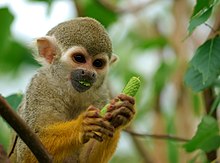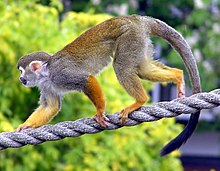Common squirrel monkey
| Common squirrel monkey | ||||||||||||
|---|---|---|---|---|---|---|---|---|---|---|---|---|

Common squirrel monkey ( Saimiri sciureus ) |
||||||||||||
| Systematics | ||||||||||||
|
||||||||||||
| Scientific name | ||||||||||||
| Saimiri sciureus | ||||||||||||
| ( Linnaeus , 1758) |
The common squirrel monkey ( Saimiri sciureus ) is a primate species from the New World monkey group .
features
Common squirrel monkeys, like all squirrel monkeys, are relatively small primates. They reach a head body length of 26 to 36 centimeters, the tail becomes 35 to 42 centimeters long. The weight is around 0.7 to 0.9 kilograms. The fur of these animals is predominantly gray-green in color, the belly is lighter. The forearms, hands and feet of most animals are colored orange-yellow, in the subspecies S. s. albigena, on the other hand, is brownish. The face, throat and tufts of ears are white, the area around the mouth is dark. The top of the head is gray-green or gray-brown, this color protrudes downwards in a V-shape between the eyes.
distribution and habitat
Common squirrel monkeys are native to northern South America. Their distribution area extends from southern Colombia , Ecuador and northern Peru as well as the three Guyanas to central Brazil . In Brazil, the Amazon forms the southern limit of their occurrence. The squirrel monkeys that live in eastern Brazil south of the Amazon have been part of the Saimiri collinsi species since 2014 .
Their habitat is forests, they are mainly found in temporarily flooded river forests and secondary forests .
Way of life
These primates are diurnal tree dwellers who tend to be in the lower tree region. They usually move on all fours, but they are very quick and dexterous.
They live in groups, which are smaller than other squirrel monkeys and usually consist of 15 to 30 animals. Groups consist of several males and females as well as the common young animals. Within the group, they establish a hierarchy that is determined, among other things, in fierce battles.
food
Common squirrel monkeys feed primarily on insects and fruits, the proportion of which can vary depending on the season. Hunting insects takes up most of the day (up to 50% of the day), eating the fruit only around 10%. The food competition within the group is high.
In addition to fruits and insects, they also occasionally consume nectar, flowers, buds, leaves and small vertebrates.
Reproduction
During the breeding season from August to October, the males gain up to 20% in weight and become more aggressive. Usually only one or two males in the group will breed, and those who have put on the most weight. After a gestation period of around 150 days, the females usually give birth to a single young between February and April. The births within a group are synchronized and occur within a week.
Raising the young is almost the sole responsibility of the females, but the males take part in guarding against predators. After about two to four months, the young animals become more independent. Females reach sexual maturity at 2.5 and males at 3.5 years of age. Both sexes then leave their birth group.
Danger
Common squirrel monkeys are widespread. In some places they suffer from the destruction and fragmentation of their habitat, but they are more adaptable than other New World monkeys. They are rarely hunted for their meat, but they are hunted to make them pets . Overall, according to the IUCN , the species is “not endangered” ( least concern ).
Systematics
The common squirrel monkey is one of six species from the squirrel monkey genus . Until the 1990s, all five South American species of this genus were sometimes combined into one species, which also bore the scientific name Saimiri sciureus .
Four subspecies are distinguished, Saimiri sciureus sciureus in the eastern Amazon basin, S. p. albigena in southern Colombia, S. p. cassiquiarensis in the central Amazon basin and S. s. macrodon in the western Amazon basin.
literature
- Thomas Geissmann : Comparative Primatology. Springer-Verlag, Berlin et al. 2003, ISBN 3-540-43645-6 .
Individual evidence
- ↑ MP Mercês, JW Lynch Alfaro, WAS Ferreira, ML Harada, JS de Silva Júnior: Morphology and mitochondrial phylogenetics reveal that the Amazon River separates two eastern squirrel monkey species: Saimiri sciureus and S. collinsi. Molecular Phylogenetics and Evolution. October 20, 2014, doi: 10.1016 / j.ympev.2014.09.020


